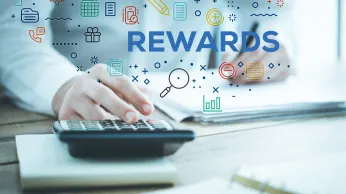8 حوافز الموظفين الناجحة: أفضل الممارسات من الشركات متعددة الجنسيات الأمريكية
حوافز الموظفين هي مفتاح النجاح المؤسسي. فهي تزيد الإنتاجية وتعزز الرضا وتعزز ثقافة إيجابية في مكان العمل. تسلط هذه المقالة الضوء على أفضل الممارسات من الولايات المتحدة.
في هذه الصفحة
تُعد حوافز الموظفين الناجحة ضرورية لتعزيز التحفيز والمشاركة والإنتاجية داخل المؤسسة. من خلال تقديم مكافآت منظمة بشكل جيد - سواء كانت مكافآت مالية أو برامج تقدير أو ترتيبات عمل مرنة - يمكن للشركات تعزيز بيئة عمل إيجابية تؤدي إلى رضا الموظفين والاحتفاظ بهم.
الأبحاث تُظهر باستمرار أن برامج الحوافز الفعالة تؤدي إلى ارتفاع مستويات الأداء، وانخفاض معدلات دوران الموظفين، وفي نهاية المطاف، تحقيق أرباح أكبر. يمكن أن يؤدي تنفيذ الحوافز المناسبة للموظفين إلى تغيير قواعد اللعبة في خلق قوة عاملة مزدهرة ومتحفزة.
ما هي حوافز الموظفين؟
حافز الموظف هو عبارة عن مكافأة أو ميزة تُقدم للموظفين لتشجيعهم على تحقيق مستويات أعلى من الأداء والمشاركة والرضا داخل المؤسسة. يمكن أن تتراوح هذه الحوافز من المكافآت النقدية مثل المكافآت المالية إلى المكافآت غير النقدية مثل برامج التقدير أو بطاقات الهدايا أو الإجازات المدفوعة الأجر. 90% من هذه الشركات تستخدم أيضًا برامج تحفيزية مماثلة لمندوبي المبيعات لديها و81% لشركاء قنوات التوزيع، مما يدل على الإيمان الواسع النطاق بفعالية هذه البرامج عبر مختلف مستويات العمليات التجارية
أهمية حوافز الموظفين
تُعد حوافز الموظفين أمرًا بالغ الأهمية لأنها تعزز بشكل كبير من مشاركة الموظفين وتحفيزهم وإنتاجيتهم، مما يؤدي إلى تحسين الأداء المؤسسي بشكل عام. ويرتبط ذلك ارتباطاً وثيقاً بأداء الأعمال.
يعمل الموظفون المتفاعلون بكفاءة أكبر ويكونون سبّاقين في تحسين أدائهم، مما يؤدي إلى زيادة المبيعات وانخفاض التكاليف وتحسين الجودة وتطوير المنتجات المبتكرة.
بالإضافة إلى ذلك، يتفوق الموظفون المتفاعلون في التواصل وتبادل الأفكار والمعلومات التي تعزز الأداء العام والابتكار. ومع ذلك تشير الأبحاث تشير إلى أن توقع المكافآت على المهام المعقدة يمكن أن يؤدي في بعض الأحيان إلى انخفاض الأداء مقارنةً بالعمل دون توقعات المكافآت.
- تتسم العلاقة بين حوافز الموظفين وأداء الشركة بالدقة. في حين أن العديد من الشركات تستثمر بكثافة في الحوافز مع توقع تحسين المشاركة والاحتفاظ بالموظفين والإنتاجية، إلا أن النتائج ليست واضحة المعالم دائمًا. عندما يتم تنفيذ خطط الحوافز بفعالية، يمكن لخطط الحوافز أن تعزز الأداء المالي بشكل كبير.
أظهر بحث أجري على 89 شركة أن الشركات التي تتمتع بمستوى عالٍ من مشاركة الموظفين شهدت نموًا في أرباح السهم الواحد 2.6 مرة أكثر من تلك التي لا تتمتع بمستوى عالٍ من المشاركة. بالإضافة إلى ذلك، ارتبطت الزيادة الملحوظة في المشاركة بارتفاع في العلاوة السوقية بنسبة 1.5%، مما قد يضيف أكثر من 230 مليون دولار إلى شركة تبلغ قيمتها السوقية 14 مليار دولار. إن نجاح برامج الحوافز غالبًا ما يتوقف على تصميمها ومواءمتها مع أهداف العمل، مما يجعل الخطط جيدة التنظيم والإبلاغ أكثر قدرة على تعزيز أداء الشركة. - الدور في الاحتفاظ بالمواهب: تُعد حوافز الموظفين أمراً بالغ الأهمية للاحتفاظ بالمواهب، حيث الدراسات أن التعويضات التنافسية ترتبط بارتفاع معدلات الاحتفاظ بالموظفين. وتجمع الاستراتيجيات الفعالة بين المزايا الملموسة وغير الملموسة، مثل خيارات العمل المرنة والتطوير المهني، والتي تجعل الموظفين 47% أقل احتمالاً للشعور بالتوتر وأكثر إنتاجية بنسبة 39%.
كما أن الشركات التي تقدم مزايا ذات قيمة عالية، مثل مايكروسوفت، والتي تساهم في انخفاض معدل دوران الموظفين، تشهد عموماً معدل دوران أقل مقارنةً بالشركات التي تقدم الحد الأدنى من المزايا. يمكن لبرامج الحوافز المدروسة أن تعزز بشكل كبير من مشاركة الموظفين وأدائهم والاحتفاظ بهم، خاصةً عندما تتماشى مع أهداف العمل واحتياجات الموظفين. - الحوافز المالية: تلعب الحوافز المالية دورًا حاسمًا في جذب أفضل المواهب والاحتفاظ بها في مشهد الأعمال التنافسي اليوم. وتؤثر هذه الحوافز، التي تشمل الرواتب التنافسية والمكافآت القائمة على الأداء وخطط تقاسم الأرباح، تأثيراً كبيراً على تحفيز الموظفين وإنتاجيتهم وأداء الشركة بشكل عام.
- الرواتب التنافسية: تُعد الرواتب التنافسية عنصراً أساسياً في الحوافز المالية، حيث تقدم حزم تعويضات تضاهي أو تفوق متوسطات الوظائف المماثلة في مواقع محددة. وتشمل هذه الحزم عادةً الرواتب الأساسية الجذابة أو الأجور بالساعة، بالإضافة إلى المزايا والامتيازات الجذابة.
هذه التعويضات ضرورية لجذب أفضل المواهب والاحتفاظ بالموظفين الحاليين. فالعديد من العمال يتركون العمل من أجل الحصول على أجور أعلى، مما يجعل الرواتب التنافسية أمراً حيوياً لمنع دوران الموظفين والحفاظ على قوة عاملة قوية.
عند تحديد الأجر التنافسي، يجب على الشركات مراعاة عدة عوامل:
- معايير الصناعة وعروض المنافسين
- معدلات التضخم
- تحليل التكاليف والفوائد.
كيف تؤثر المكافآت ومشاركة الأرباح على الموظفين؟
وجدت دراسة أن ماكدونالدز وبرجر كينج يقدمان رواتب متشابهة للوظائف المتشابهة، حيث يبلغ متوسط رواتب أفراد الطاقم 10.29 دولار و10.51 دولار في الساعة، على التوالي. وهذا يوضح كيف أن المتنافسين يحاسبون بعضهم البعض على الأجور في نفس الصناعة. وتوضح الدراسة أن المكافآت والأجور التنافسية وتقاسم الأرباح يمكن أن يكون لها تأثير على الموظفين.
أظهرت الأبحاث أن الأجر المستند إلى الأداء يمكن أن يكون له آثار إيجابية وسلبية على حد سواء:
- إيجابية: يشجع الموظفين على العمل بجدية أكبر وتحقيق نتائج أفضل للشركة.
- سلبي: قد يعمل الموظفون فوق طاقتهم، مما يؤدي إلى انخفاض الرضا الوظيفي واحتمال ارتفاع معدلات دوران الموظفين.
A دراسة نُشرت في مجلة إدارة الموارد البشرية أن الموظفين الذين يتلقون أجورًا مرتبطة بالأداء يعملون بجدية أكبر ولكنهم يعانون من مستويات توتر أعلى ورضا وظيفي أقل. ومع ذلك، عندما يتم توزيع الأجر المرتبط بالأداء بشكل متساوٍ في جميع أنحاء المؤسسة، يمكن أن يزيد من الرضا الوظيفي والتزام الموظفين والثقة في الإدارة.
تقاسم الأرباح هي طريقة تعويض يحصل فيها الموظفون على جزء من أرباح الشركة بالإضافة إلى رواتبهم العادية. يعمل هذا النهج على مواءمة مصالح الموظفين مع ربحية الشركة ويعمل كحافز لزيادة المشاركة والإنتاجية.
أنواع خطط تقاسم الأرباح
هناك ثلاثة أنواع رئيسية من خطط تقاسم الأرباح:
- خطة تقاسم الأرباح الحالية: يدفع أرباب العمل مكافأة عند تخصيص الأرباح، عادةً سنوياً، مما يوفر مكافأة فورية للموظفين.
- خطة تقاسم الأرباح المؤجلة: يتم تحديد وقت السحب في وقت لاحق، وغالبًا ما يتم دمجها مع خطة 401 (ك)، مما يجعلها غير خاضعة للضريبة في نهاية المدة.
- خطة تقاسم الأرباح الهجينة: مزيج من النوعين المذكورين أعلاه، يقدم مزايا فورية ومدخرات طويلة الأجل.
تحت قيادة غريغ وايلدبير، طبقت شركة WPL نموذجاً شفافاً لتقاسم الأرباح يركز على العدالة والبساطة. من خلال عقد اجتماعات شهرية للتحديث المالي منذ عام 2016، تتبعت الشركة ميزانيتها مقابل النفقات والأرباح في مختلف الأقسام مثل إزالة الثلوج وتنسيق الحدائق.
وقد أدى هذا النهج إلى نمو مطرد في مجموعة تقاسم الأرباح في WPL، والتي وصلت إلى أكثر من 150,000 دولار في سبتمبر 2023، مع توقعات بوصولها إلى 200,000 دولار بحلول نهاية العام. ونتيجة لذلك، ارتفعت عائدات WPL من أقل من 4 ملايين دولار إلى 10 ملايين دولار في سبع سنوات فقط، مما يسلط الضوء على فعالية استراتيجية مشاركة الأرباح في تعزيز ولاء الموظفين ونمو الأعمال.
الفعالية الحوافز المالية وفقًا ل HBR، يجب أن تتماشى برامج الحوافز المالية الفعالة مع الأهداف الاستراتيجية، وأن توازن بين المكافآت قصيرة الأجل وطويلة الأجل، وأن تعالج الأداء الفردي والجماعي على حد سواء. على سبيل المثال، استخدمت شركة سلع استهلاكية حوافز للمبيعات السنوية وأداء الأسهم على المدى الطويل.
وباختصار، يمكن للحوافز المالية المصممة بشكل جيد أن تعزز تحفيز الموظفين وأداء الشركة، مما يجعل مزيجًا من الرواتب التنافسية والمكافآت ومشاركة الأرباح مفيدًا لتعزيز قوة عاملة منتجة.
لا يسهل هذا النظام الحوافز النقدية فحسب، بل يشجع أيضاً على التقدير غير النقدي، مثل التقدير الاجتماعي وتقدير الأقران، وهو أمر بالغ الأهمية لتعزيز ثقافة إيجابية في مكان العمل.
8 أنواع من حوافز الموظفين الناجحة
فيما يلي 8 أنواع من حوافز الموظفين التي تعمل بشكل إعجازي.
- الحوافز غير المالية: تلعب الحوافز غير المالية دورًا حاسمًا في جذب أفضل المواهب والاحتفاظ بها في مشهد الأعمال التنافسي اليوم. تتجاوز هذه الحوافز التعويضات المالية وتركز على خلق بيئة عمل إيجابية تدعم رفاهية الموظفين ونموهم ورضاهم. دعنا نستكشف بعض الحوافز غير المالية الأكثر فاعلية التي تطبقها الشركات الناجحة.
- ترتيبات العمل المرنة: ازدادت شعبية ترتيبات العمل المرنة، حيث أظهرت دراسة أجراها موقع LinkedIn أن 31% من المستخدمين يعتبرونها عاملاً حاسماً في العمل. وقد دفع هذا الاتجاه العديد من الشركات إلى تبني سياسات مرنة لجذب المواهب والاحتفاظ بها.
- فرص التطوير المهني: تلبي الشركات بشكل متزايد رغبة المهنيين الشباب في النمو الوظيفي والتعلم المستمر من خلال تقديم أكثر من مجرد مكافآت مالية.
تدعم مايكروسوفت التطوير المهني بشكل فريد من خلال مزايا العافية التي تبلغ 1500 دولار أمريكي، والتي يمكن استخدامها لعضوية الصالة الرياضية والتدريب على نمط الحياة والاستشارات الغذائية. يؤكد هذا النهج على الصلة بين الرفاهية البدنية والتقدم الوظيفي، مما يعكس اتجاهًا أوسع نطاقًا لدمج الدعم الشامل في برامج تطوير الموظفين.
4. مبادرات التوازن بين العمل والحياة الشخصية: أصبح تحقيق التوازن بين العمل والحياة الشخصية أولوية رئيسية للموظفين، مما يؤثر على بحثهم عن عمل أكثر من أي وقت مضى. واستجابة لذلك، تطرح الشركات مبادرات لتعزيز رفاهية الموظفين. فعلى سبيل المثال، تعمل شركة Buffer على تعزيز الصحة العقلية من خلال تقديم اشتراك مجاني في موقع AbleTo و"يوم سنوي غير مريض" من أجل الصحة الوقائية.
5. برامج التقدير: تلعب برامج التقدير دورًا حاسمًا في تحفيز الموظفين، وتوفير الشعور بالإنجاز، وجعلهم يشعرون بتقديرهم لعملهم. لا تعزز هذه البرامج مشاركة الموظفين الفردية فحسب، بل تزيد أيضًا من الإنتاجية والولاء للشركة، مما يؤدي إلى ارتفاع معدلات الاحتفاظ بالموظفين. يمكن أن تكون برامج التقدير الفعالة منخفضة التكلفةمثل الملاحظات الشخصية أو بطاقات الشكر، ولكن المفتاح هو فهم ما يجعل التقدير ذا معنى ولا يُنسى بالنسبة للموظف.
6. الاعتراف من نظير إلى نظير: أصبح الاعتراف من نظير إلى نظير يحظى بشعبية متزايدة بين الشركات الناجحة. ويمكّن هذا النهج الموظفين من تقدير مساهمات بعضهم البعض، مما يعزز ثقافة التقدير والاحترام المتبادل.
7. التقدير العلني: يُعد التقدير العلني طريقة فعالة أخرى للاعتراف بإنجازات الموظفين. يساعد هذا النهج في بناء شبكات العلاقات المهنية ويعزز السلوكيات الإيجابية التي تتماشى مع قيم الشركة. ويمكن أن تُظهر الصيحات العلنية على منصات التواصل الاجتماعي أو النشرات الإخبارية على مستوى الشركة أصحاب الأداء العالي وإنجازاتهم.
8. الجوائز والاحتفالات
توفر الجوائز والاحتفالات الرسمية نهجاً منظماً لتقدير الموظفين، وغالباً ما تحتفل بالإنجازات أو المعالم الهامة.
برنامج "روح الخدمة" التابع لشركة ماريوت الدولية، والذي يسمح للمديرين بتكريم الموظفين الذين يقدمون التميز.
أفضل ممارسات حوافز الموظفين
عند تنفيذ برامج التقدير، يجب على الشركات مراعاة أفضل الممارسات التالية عند تنفيذ برامج التقدير:
- الاعتراف المتكرر: التواصل مع التقدير في الوقت الحقيقي وبشكل منتظم لجعله جزءًا من الثقافة اليومية.
- التوافق مع قيم الشركة: تأكد من أن برنامج الجوائز يعزز السلوكيات الرئيسية التي تعكس قيم الشركة وعلامتها التجارية.
- دمج نقاط المكافآت: استخدم منصة تقدير الموظفين التي تدعم التقدير القائم على النقاط، مما يسمح لأعضاء الفريق باختيار المكافآت التي يريدونها.
- ابتكر أسماء جوائز لا تُنسى: بدلاً من العناوين العامة، استخدم أسماء فريدة لا تُنسى للجوائز لجعلها أكثر تأثيراً.
من خلال تنفيذ برامج تقدير مصممة بشكل جيد تتضمن تقدير الأقران والتقدير العام والجوائز الرسمية، يمكن للشركات خلق قوة عاملة أكثر تفاعلاً وإنتاجية ورضا. لا تعزز هذه البرامج معنويات الموظفين فحسب، بل تساهم أيضًا في تعزيز ثقافة إيجابية في مكان العمل وتحسين الأداء العام.
أمثلة من الشركات الأمريكية متعددة الجنسيات
فيما يلي أمثلة على الشركات الأمريكية متعددة الجنسيات التي تطبق حوافز الموظفين التي تناسبها.
1. عمالقة التكنولوجيا: جوجل ومايكروسوفت
جوجل ومايكروسوفتوهما عملاقان رائدتان في مجال التكنولوجيا، طبقتا برامج تحفيزية متميزة للموظفين لجذب أفضل المواهب والاحتفاظ بها. في حين أن كلا الشركتين تقدمان تعويضات تنافسية، إلا أن جوجل تركز على خلق ثقافة منفتحة وأقل تسييساً، تكملها امتيازات كبيرة مثل الطعام المجاني والوجبات الخفيفة ووسائل الراحة مثل آلات الكرة والدبابيس وصالات البولينج. كما أن بيئة العمل في جوجل جذابة بشكل ملحوظ، مع وجود سياسات أكثر سخاءً فيما يتعلق بالإجازات وخيارات أفضل لسداد الرسوم الدراسية التي تمتد إلى الدورات المتعلقة بالوظيفة وغير المتعلقة بالوظيفة.
من ناحية أخرى، تقدم مايكروسوفت ثقافة إدارية أكثر تنظيماً تقدر الكفاءة الاجتماعية إلى جانب المهارات التقنية. وفي حين أن سياسة الإجازات التي تتبعها الشركة أقل سخاءً من سياسة جوجل، تتفوق مايكروسوفت في مجالات مثل توفير مرافق رياضية ممتازة بالقرب من حرمها في ريدموند وتقديم بطاقة مجانية للشركة مع خصومات محلية.
كما تركز الشركة أيضاً تركيزاً قوياً على التواصل الواضح بشأن تعويضاتها ومزاياها من خلال بوابة إجمالي المكافآت (TRP)التي تم إطلاقها داخلياً في يوليو 2021. تعمل البوابة كمنصة شاملة لأكثر من 220,000 موظف عالمي، حيث تقدم توضيحاً للعناصر الملموسة وغير الملموسة لحزم التعويضات الخاصة بهم.
2. رواد البيع بالتجزئة: وول مارت وأمازون
تتنافس وول مارت وأمازون بشراسة على كل من الحصة السوقية والمواهب في قطاع البيع بالتجزئة. أحدثت أمازون ضجة كبيرة عندما رفعت الحد الأدنى للأجور إلى 15 دولارًا لجميع موظفيها في الولايات المتحدة، ولكن هذه الخطوة أثارت بعض الانتقادات حيث خفضت الشركة في الوقت نفسه المكافآت التي غالبًا ما كانت تزيد من الأرباح الشهرية بنسبة 8%.
أطلقت وول مارت مبادرة "مكان العمل الرائع" لتعزيز نمو الموظفين وأجورهم بدلاً من مجاراة الزيادة في أجور أمازون. ويشمل هذا البرنامج فرص التدريب المتبادل واستحداث وظائف جديدة، مثل شركاء الفريق الذين يبدأ أجرهم من 12 دولاراً في الساعة وقادة الفرق بسعر 18 دولاراً في الساعة.
وفي الوقت نفسه، طرحت أمازون مزايا جديدة لدعم رفاهية الموظفين، بما في ذلك صندوق ادخار للطوارئ، وتطبيق للصحة النفسية، وتوسيع نطاق الوصول إلى الاستشارات المالية والدعم النفسي الافتراضي. وزادت الشركة عدد جلسات الاستشارة العامة المجانية للموظفين من ثلاث إلى خمس جلسات سنوياً، وأضافت 24/7 دعم الصحة النفسية الافتراضي على مدار الساعة طوال أيام الأسبوع من خلال تطبيق Twill.
3. القطاع المالي: جيه بي مورغان تشيس وجولدمان ساكس
قام كل من بنك جيه بي مورجان تشيس وجولدمان ساكس مؤخرًا بإصلاح هياكل المكافآت الخاصة بهما استجابةً للتغييرات التنظيمية وضغوط السوق. فقد انضم بنك جيه بي مورجان إلى جولدمان في رفع الحد الأقصى لمكافآت المصرفيين في لندن، حيث يسمح الآن بمكافآت تصل إلى 10 أضعاف الراتب الأساسي، وهي زيادة كبيرة عن الحد الأقصى السابق الذي كان يبلغ ضعفين. وذهب بنك جولدمان ساكس إلى أبعد من ذلك، حيث سمح لكبار المتداولين وصانعي الصفقات في المملكة المتحدة بالحصول على مكافآت تصل إلى 25 ضعف ضعف الراتب الأساسي، على الرغم من أن هذا قد يؤدي إلى انخفاض الأجر الثابت لبعض الموظفين.
تتزامن هذه التغييرات مع المناقشات الجارية بين الجهات التنظيمية المصرفية لتشديد قواعد تعويضات المسؤولين التنفيذيين. وستتطلب اللوائح المقترحة من البنوك الكبيرة تأجيل أجور المديرين التنفيذيين وتنفيذ أحكام استرداد الأموال في حالة حدوث خسائر مالية. في العام الماضي، بلغ متوسط المكافأة في وول ستريت 176,500 دولار أمريكي، مع حصول العاملين في مجال الأوراق المالية في نيويورك على رقم قياسي $240,400.
الخاتمة
تؤثر حوافز الموظفين بشكل كبير على ديناميكيات مكان العمل ونجاح الشركة، مما يعزز الإنتاجية والرضا الوظيفي والاحتفاظ بالموظفين. توضح شركات أمريكية رائدة متعددة الجنسيات مثل Google وJP Morgan Chase استراتيجيات متنوعة، بدءاً من الثقافات المفتوحة ذات الامتيازات السخية إلى إزالة الحدود القصوى للمكافآت. يعد تكييف برامج الحوافز مع توقعات الموظفين المتغيرة ومتطلبات السوق أمرًا ضروريًا لخلق قوة عاملة منتجة ومشاركة في العمل ودفع عجلة نجاح الأعمال.
Empuls من Giift مثالاً على حوافز الموظفين الفعّالة التي تعمل من خلال تقديم منصة شاملة لمكافأة الموظفين وإشراكهم. ويوفر هذا الحل المبتكر مجموعة من الميزات، بما في ذلك برامج المكافآت المخصصة، والتقدير في الوقت الفعلي، والتحليلات التفصيلية لتعزيز تحفيز الموظفين والاحتفاظ بهم. من خلال دمج خيارات المكافآت وأدوات التقدير القابلة للتخصيص، يساعد Empuls الشركات على إنشاء برنامج حوافز ديناميكي يتوافق مع الأهداف المؤسسية ويلبي توقعات الموظفين. لمزيد من المعلومات، قم بزيارة الموقع الإلكتروني الرسمي Empuls هنا.
الأسئلة الشائعة
1. ما هي أكثر الطرق فعالية لتحفيز الموظفين؟
يمكن تحقيق التحفيز الفعال للموظفين من خلال حوافز مختلفة مثل المكافآت المالية، وزيادة الرواتب، وأيام الإجازات الإضافية، والتقدير العام، وتعويضات الصحة والعافية، ومكافآت الإحالة، وفرص التطوير المهني، وسداد الرسوم الدراسية.
2. لماذا تعتبر برامج الحوافز مفيدة للموظفين؟
تُعد برامج الحوافز بالغة الأهمية لأنها تعزز الإنتاجية وتقلل من معدل دوران الموظفين وتقلل من التكاليف التشغيلية. تعمل هذه البرامج على تعزيز المشاركة وتشجيع العمل الجماعي ورفع الروح المعنوية والتحفيز بين الموظفين.
3. ما هي أفضل الممارسات لإنشاء برنامج حوافز للموظفين؟
لإنشاء برنامج حوافز فعال للموظفين، ابدأ بمواءمة البرنامج مع أهداف عملك. يجب أن يكون البرنامج بسيطاً ولكنه مليء بالتحديات، وأن يربط المكافآت بالأداء بدلاً من الربح، وأن يضمن العدالة، وأن يقدم مكافآت يرغب فيها الموظفون بصدق، وأن يتسم بالمرونة.
4. كيف يمكن استخدام المكافآت والحوافز لتعزيز أداء الموظفين؟
يعد الاستثمار في نمو الموظفين طريقة قيّمة لمكافأتهم. إن تقديم فرص التطوير المهني للموظفين ذوي الأداء العالي يمكن أن يساعدهم على اكتساب مهارات جديدة والتقدم في حياتهم المهنية والشعور بمزيد من الالتزام بعملهم.
5. ما هو دور تقدير الأقران في مكان العمل؟
تقدير الأقران يمكّن الموظفين من الاعتراف بمساهمات بعضهم البعض، مما يعزز ثقافة التقدير والاحترام المتبادل. ويساعد هذا النهج على بناء بيئة عمل إيجابية ويمكن أن يؤدي إلى ارتفاع أداء الفريق بشكل عام.
6. كيف يستخدم عمالقة التكنولوجيا مثل جوجل ومايكروسوفت حوافز الموظفين؟
تقدم Google مجموعة من الامتيازات مثل الطعام المجاني وسياسات الإجازات الشاملة والدعم التعليمي، بينما توفر Microsoft إدارة منظمة وبوابة شاملة للمكافآت الشاملة للتواصل الواضح بشأن المزايا والتعويضات.













